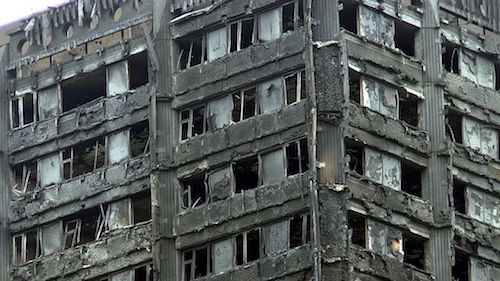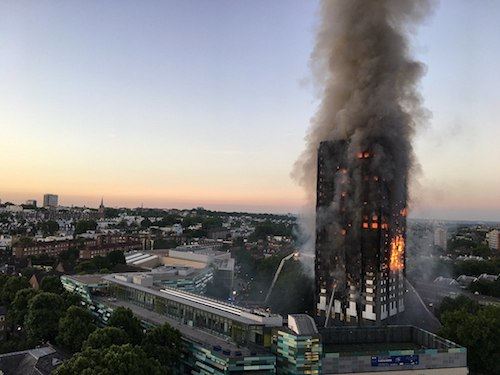Grenfell Inquiry Looks at Contractor, Worries
WEDNESDAY, AUGUST 5, 2020
Recent testimony of the Grenfell Inquiry have focused on the contractor for the Grenfell Tower’s 2015 refurbishment, Rydon, with focus on how the company handled concerns not only about the installation of the cladding itself, but how the work was being led as well.
The inquiry is now on summer recess until Sept. 7.
Disaster Background
On June 14, 2017, Grenfell Tower—a 24-story, 120-home apartment building—caught fire and resulted in the death of 72 people. While the fire started in a fridge-freezer in an apartment on the fourth floor, the blaze then spread to a nearby window. The building had recently undergone a $12.73 million renovation designed by Studio E Architects that was completed in the spring of 2016 and is largely believed to be responsible for why the fire spread so quickly.
At that time, the building was refurbished with a system of polyester powder-coated aluminum rain-screen panels, insulated exterior cladding and double-glazed windows, as well as a communal heating system.
A Guardian investigation in 2018 revealed that nonflammable aluminum panels had initially been proposed for the refurb but were switched out to save money.
The publication found that, at first, under the local government’s preferred contractor, Leadbitter, subcontractor D+B Facades had provided a 3.3 million-pound (roughly $4.1 million) quote to fit a system of aluminum panels backed with mineral wool insulation.

 |
| ChiralJon, CC-SA-BY 2.0, via Wikimedia Commons |
|
Recent testimony of the Grenfell Inquiry have focused on the contractor for the Grenfell Tower’s 2015 refurbishment, Rydon, with focus on how the company handled concerns not only about the installation of the cladding itself, but how the work was being led as well. |
A few months later, the council decided that Leadbitter wanted to spend too much on the refurbishment, and put the contract out to tender to save about 1.3 million pounds. It went with a different contractor, Rydon, which provided a lower bid, but fitted the tower with the combustible cladding that authorities believe contributed to the number of fatalities in the fire.
The Guardian found that the council had originally wanted to spend 6 million pounds on Grenfell, but later set a different budget of 9.7 million pounds, because it realized it needed to replace the heating system. Leadbitter was on course to spend 11.3 million pounds, which is why council says it put the contract back out.
Manufacturer Omnis Exteriors confirmed that they supplied the Arconic Architectural Product to Harley Facades—the subcontractor that Rydon utilized for the cladding work.
Around the same time in 2018, BBC News uncovered that the Reynobond PE cladding was subjected to European tests in 2014 and 2015 for “reaction to fire,” in which products are typically given an A to F rating, with A being the highest.
(Many officials believed that the legal standard for such towers was a B rating. While that belief had been contested among industry professionals, the legal minimum rating now, post-Grenfell fire, has been upgraded to A.)
The reports from the 2014-15 tests reveal that two types of the Reynobond, both of which were installed at Grenfell, had less than B ratings. One type, called “riveted,” received a C classification, while another, “cassette,” received an E classification.
The BBC obtained correspondence from Arconic to clients confirming the ratings.
The Inquiry
Phase One of the inquiry was completed last fall, with the findings published on Oct. 30. This phase was to look at what happened on the night of the fire itself, and the 1,000-page report criticized not only the response to the fire but the 2016 renovation as well.
Arguably of most importance, inquiry head Sir Martin Moore-Bick, a retired Court of Appeals judge, said that it seems that the refurbishment did not comply with the building regulations requirement to adequately resist the spread of fire.
“There is compelling evidence that Requirement B4(1) was not met in this case,” he said. “It would be an affront to common sense to hold otherwise.”
In addition to the preliminary conclusions on the 2016 refurbishment, the report also accuses the fire brigade’s response to the fire as having “systematic failures” with no contingency plan to evacuate the tower. It also criticized the brigade’s decision to maintain the “stay-put policy” even when the stairs were passable.
After the report, Dany Cotton, the London Fire Commissioner who was in charge of the response, resigned.
The second phase, which started Jan. 27, is to examine the refurbishment, including the installation of flammable cladding.
According to the Telegraph, this phase is said to be more complex than the first, which took 16 months to complete. Preparation for this phase has reportedly unearthed 200,000 documents and the phase will be split into eight “modules,” with 21 companies and 600 individuals named as “core participants.”
Among the modules, the areas that will be investigated include the refurbishment itself, the testing of the cladding, complaints from residents prior to the fire, the management of the building and the aftermath of it all.
Some estimates say that it could take Moore-Bick until at least 2023 to publish a final report. Only then would police and prosecutors get a chance to review the findings and then pursue charges, if any.
A few days into the second phase, after much finger-pointing, lawyers for Studio E, Rydon, the TMO and Harley wrote to Moore-Bick arguing that their clients could claim privilege against self-incrimination and not answer questions, noting that they would only speak openly if the attorney general gave an understanding that nothing they said would be used against them in criminal prosecution.
In late February, United Kingdom Attorney General Suella Braverman announced that she was granting the undertaking. In her letter to Moore-Bick, Braverman wrote that receiving “substantive answers” to questions in the probe is of an important public interest.
Therefore, the undertaking will cover people, will not impact the ongoing criminal investigation and will not jeopardize criminal prosecutions.
In early March, lead architect, Bruce Sounes, admitted that he had not read the Building Regulations covering fire safety in high-rises.
He said that he was “largely unaware there was specific guidance in Approved Document B for buildings taller than 18 meters and did not know that aluminum panels could melt.”
After Sounes admitted to not reading the regulations, inquiry lawyer Kate Grange asked what steps he did take to familiarize himself with the project and with Approved Document B.
Sounes pointed to the use of fire consultants and claimed that the design responsibilities should have fallen on design-build contractor Rydon.
However, the lawyer pointed to a document between Studio E and Rydon that specified Studio’s duties. They included: “seek to ensure that all designs comply with the statutory requirements” and “with other consultants, where appointed, develop the scheme designs, agree with the contractor the type of construction and quality selection of materials.”
In addition, it also came to light that the tenant management organization had breached regulations in the appointment of Studio E in the first place. Studio E, reportedly, deliberately deferred a chunk of its fees to stay under the threshold that would trigger an open public tender for design services.
The practice also admitted to having no experience in overcladding or refurbishing high-rises, meaning that it would’ve been unlikely that the firm would have won any public competitive procurement process.
Instead, the Studio landed the job “on the back of its work for the local council on the linked Kensington Academy and Leisure Centre.”
 |
| Natalie Oxford, CC-SA-BY 4.0, via Wikimedia Commons |
|
The most recent testimony revealed that a site manager on the refurbishment, who was responsible for overseeing the installation of overcladding and window insulation, was moved from the project because of concerns on his work. |
Shortly after that testimony, meanwhile, Studio E associate Neil Crawford blamed the government for not amending the regulations on cladding systems when there were known problems.
Shortly before the hearing’s suspension, Studio E continued to testify, revealing that Sounes urged his client for the refurbishment to not show the fire brigade the fire safety plans because the brigade might support “a severe interpretation of the regulations.”
The inquiry was then paused on March 16 and then resumed at the beginning of this month.
The first testimonies after the hiatus revealed that the principal fire engineer for the tower’s refurbishment did not order a separate fire assessment of the cladding.
The hearing wrapped up testimony with the architecture firm last month, and Sounes told the inquiry that he had originally wanted to use the non-combustible Rockwool insulation for the tower cladding.
However, engineering firm Max Fordham had put for a U-value target of 0.15W/m²K for the insulation, with a specification of 150-200mm.
Sounes said that the amount of Rockwool required would have pushed the cladding line out to around 450mm, which was “unfeasible” because of the targets, which is when the Celotex RS5000 was suggested.
What Now
The most recent testimony revealed that a site manager on the refurbishment, who was responsible for overseeing the installation of overcladding and window insulation, was moved from the project because of concerns on his work.
A contract manager, Simon Lawrence, reportedly wrote to Stephen Blake, refurbishment director, about Daniel Osgood, saying that Osgood “couldn’t be bothered” to check if the work was being done correctly.
Lawrence said that the work done in the show flat (the first property that was to showcase the standard for the refurbishment) was sub-par and that the work was never remediated.
Lawrence said, “[Osgood] is just a chancer who wants to do as little as possible and not be responsible for anything. Currently he is demotivating the others on site and none of the subbies want to deal with him. He needs to be moved ASAP.”
Osgood testified that he disagreed with the critiques on his work.
Before these statements, however, Lawrence had already come under fire in the testimony after multiple concerns from the Kensington and Chelsea Tenant Management Organization either were ignored or not taken seriously.
The inquiry heard that Lawrence had received an email from Clair Williams of the KCTMO seeking clarification on whether the cladding would resist a fire; the email referenced a “Lakanal moment,” which referred to a 2009 high-rise fire in London.
According to the inquiry, there is no evidence that anyone at Rydon responded to the email.
In addition to the email incident, another member of the TMO, David Gibson, said in a witness statement that he had asked Lawrence if there would be a “Lakanal type problem” in regard to the gaps between the insulation and the cladding.
Gibson said that Lawrence assured him that the materials wouldn’t burn and were “inert.”
Lawrence testified saying he didn’t remember being asked this question and denied that he would give a technical assurance of that nature.
Tagged categories: Building envelope; Building Envelope; Cladding; Condominiums/High-Rise Residential; Fatalities; Fire; Government; Health and safety; Lawsuits; Safety







